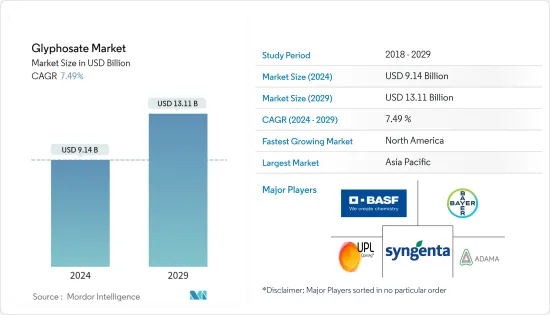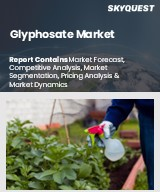
|
시장보고서
상품코드
1443978
세계 글리포세이트 시장 : 점유율 분석, 산업 동향과 통계, 성장 예측(2024-2029년)Glyphosate - Market Share Analysis, Industry Trends & Statistics, Growth Forecasts (2024 - 2029) |
||||||
글리포세이트 시장 규모는 2024년에 91억 4,000만 달러로 추정되며, 2029년에는 131억 1,000만 달러에 이를 것으로 예측되며, 예측 기간 중(2024-2029년) CAGR은 7.49%로 성장할 것으로 예측됩니다.

주요 하이라이트
- 제초제 내성 작물의 재배 면적이 증가하고 작물에 대한 제초제 내성 기술을 승인하는 국가가 늘어나는 가운데 시장은 농가의 급속한 도입으로 무기적으로 성장할 것으로 예상됩니다. 저비용, 토양 감소, 환경 악화와 같은 기계적 경작 시스템에 대한 제품의 이점은 글리포세이트 시장의 확대를 지원합니다. 신흥국 시장에서는 환경파괴에 대한 우려가 남아 있지만, 글리포세이트의 효율적인 대체제가 없기 때문에 시장의 성장은 둔화되지 않을 것으로 예상됩니다.
- 야채 생산자에게 전달되는 이점의 대부분은 글리포세이트의 다용도와 유연성에 관한 것입니다. 글리포세이트는 거의 모든 야채 작물에 등록되어 있으며 대부분의 상황에서 사용할 수 있습니다. 글리포세이트의 총 사용 면적의 대부분은 농작물에서 작물에 후기 살포될 때 발생합니다. 북미와 아시아태평양은 글리포세이트에게 유리한 시장입니다. 유전자 변형 작물의 도입은 경작 가능한 토지 확보와 함께 향후 수년간 아시아태평양의 글리포세이트 시장을 견인할 것으로 예상됩니다.
- 글리포세이트는 현재 유럽 연합(EU)에서 2022년 12월 15일까지 사용이 승인되었습니다. 이는 당일까지 PPP의 활성 물질로 사용할 수 있음을 의미하며, 각 제품은 안전성 평가와 함께 국가 당국에 의해 승인됩니다. 유럽식품안전기구(EFSA)는 농약 재평가에 더 많은 시간이 소요되며 2023년 7월에 연기되었습니다.
- 2022년 인도 정부는 인간과 동물의 건강 위험을 우려하고 글리포세이트의 사용을 제한했습니다. 그러나 정부는 해충 제거제(PCO)를 통한 사용만 허용했습니다. PCO는 설치류와 같은 해충을 치료하기 위해 살상력이 있는 화학제품을 사용하는 허가를 받았습니다. 글리포세이트와 그 제형은 널리 등록되어 있으며 현재 유럽 연합(EU)과 미국을 포함한 160개국 이상에서 사용되고 있습니다.
글리포세이트 제초제 시장 동향
유전자 변형 제초제 내성 작물의 상업화
강력한 제초제에 내성이 있는 제초제 내성(HT) 작물은 농부에게 효과적인 잡초 방제를 위한 다양한 옵션을 제공합니다. 또한 농부는 잡초를 제거하기 위해 일반적으로 수행하는 토양 경기의 필요성을 제거합니다. 미국 농무부에 따르면 유전자 변형 제초제 내성 작물은 현재 세계 글리포세이트 사용량의 약 56%를 차지하고 있습니다. 유전자 변형(GE) 씨앗은 미국에서 주요 농작물에 상업적으로 도입되었고, 도입률은 빠르게 증가하고 있습니다. 미국에서는 현재 옥수수, 면화, 콩의 90% 이상이 GE 품종을 사용하여 생산되고 있습니다. 강력한 제초제(글리포세이트, 글루포시네이트, 디캄바 등)에 내성이 있는 제초제 내성(HT) 작물은 농부에게 효과적인 잡초 방제를 위한 다양한 옵션을 제공합니다.
미국 농무부의 조사 데이터에 따르면 2021년과 2022년 대두의 HT작성 면적은 95%로 약간 증가했으며, 면화는 2021년 94%로 최고를 기록했습니다. 2022년에는 국내 옥수수 제작 면적의 약 90%가 HT 종자로 만들어졌습니다. 미국에서 이렇게 집중적이고 광범위하게 사용되는 농약은 없습니다. 글리포세이트는 앞으로도 세계에서 가장 널리 사용되는 농약으로 남아있을 수 있으며 생태계와 인간의 건강에 미치는 영향을 정량화하는 데 수요가 높아질 수 있습니다.
제작 면적이 수백만 에이커에 달하는 대두, 옥수수, 면화, 사탕무 등의 대형 밭 작물은 그리포세이트의 총 처리 면적과 살포량이 가장 많습니다. 연간 평균으로 글리포세이트의 84%가 콩, 옥수수, 면화에 살포됩니다. 이 3가지 농작물에는 글리포세이트 내성(GR) 품종이 있으며 널리 채용되고 있습니다. 농작물의 1회 평균 살포량은 0.72-1.00파운드 ae/에이커입니다. 이와 같이, 글리포세이트는 광범위하게 살포할 수 있어, 사용법이 간단하고, 비용효과도 높다는 성질로부터, 농업의 현장에서 유저에게 유용한 제초제로 계속되고 있습니다.
아시아태평양과 북미가 잠재적 시장
아시아태평양 및 북미는 글리포세이트 제초제 시장 진출기업들에게 똑같이 매력적인 시장입니다. 제초제 내성 하이브리드의 보급이 진행되고 있기 때문에 북미는 글리포세이트의 최대 시장의 하나로 계속될 것으로 예상됩니다. 미국의 글리포세이트 사용량의 거의 56%는 제초제 내성 작물용으로 추정됩니다. 북미에서는 감자, 호박, 알팔파, 가지, 사탕무, 파파야, 나타네, 옥수수, 콩, 면화 등의 유전자 변형 작물이 상업적으로 재배되고 있습니다.
아시아태평양에서는 시장의 급성장이 예상됩니다. 이 지역은 세계에서 가장 경작지 면적이 넓고 작물의 다양성이 가장 높습니다. 불경기 재배와 같은 선진적인 농법의 채용이 증가하고 있으며, 이 지역의 글리포세이트 제초제 시장의 성장이 기대됩니다. 그러나 중국은 제초제 내성이 있는 하이브리드 작물의 재배를 승인하고 있습니다.
제초제에 내성이 있는 유전자 변형 작물은 농부가 작물에 손상을 주지 않고 잡초를 방제하는 데 도움이 됩니다. 예를 들어, 링 스팟 바이러스가 하와이 파파야 산업과 하와이 파파야 농부의 삶을 위협했을 때, 식물 과학자는 유전자 변형 파파야라고 불리는 링 스팟 바이러스 내성의 레인보우 파파야를 개발하여 지금은 하와이 전역에서 재배되고, 일본에도 수출되고 있습니다. 게다가, 유전자 재조합(GM) 작물은 농업 온실가스(GHG) 배출을 줄이고 생산 배출을 줄일 수 있습니다. 유전자 재조합 작물의 수율 증가는 토지 이용의 변화와 관련된 배출을 완화시킵니다.
환경부는 GM 작물의 상업적 재배를 지지하는 사람들을 위해 GM 겨자의 재배를 승인했습니다. GM 작물에는 수율 증가로 인한 식량 안보 향상, 식량 생산 비용 절감, 농약 필요성 감소, 병해충에 대한 내성 등이 포함됩니다. 트랜스제닉 겨자 하이브리드 DMH-11은 인도의 작물 유전자 조작 센터(CGMCP)에 의해 개발되었습니다. 정부가 상업재배를 승인한 유전자 변형 작물은 현재 Bt면 1유형뿐입니다.
글리포세이트 제초제 산업 개요
세계의 글리포세이트 시장은 Bayer CropScience AG, BASF Corporation, Syngenta AG, Adama Agricultural Solutions Ltd, UPL Limited 등 기업이 지배적이고 통합되어 있습니다. 이러한 기업들은 세계 신제품 출시, 제휴, 합병, 인수에 주력하여 사업 활동을 확대하고 있습니다.
기타 혜택:
- 엑셀 형식 시장 예측(ME) 시트
- 3개월간의 애널리스트·지원
목차
제1장 서론
- 조사의 전제조건과 시장 정의
- 조사 범위
제2장 조사 방법
제3장 주요 요약
제4장 시장 역학
- 시장 개요
- 시장 성장 촉진요인
- 시장 성장 억제요인
- Porter's Five Forces 분석
- 공급기업의 협상력
- 구매자의 협상력
- 신규 참가업체의 위협
- 대체품의 위협
- 경쟁 기업간 경쟁 관계의 강도
제5장 시장 세분화
- 유형
- 유전자 변형 작물
- 비유전자 재조합 작물
- 용도
- 곡물 및 곡류
- 콩류 및 지방종자
- 과일 및 채소
- 상업 작물
- 기타 작물
- 지역
- 북미
- 미국
- 캐나다
- 멕시코
- 기타 북미
- 유럽
- 스페인
- 이탈리아
- 프랑스
- 독일
- 러시아
- 영국
- 기타 유럽
- 아시아태평양
- 인도
- 중국
- 일본
- 호주
- 기타 아시아태평양
- 남미
- 브라질
- 아르헨티나
- 기타 남미
- 아프리카
- 남아프리카
- 기타 아프리카
- 북미
제6장 경쟁 구도
- 가장 채용된 전략
- 시장 점유율 분석
- 기업 프로파일
- Adama Agricultural Solutions Ltd
- BASF SE
- Bayer Cropscience AG
- UPL Limited
- FMC Corporation
- Zhejiang Xinan Chemical Industrial Group Company Ltd
- Nufarm Limited
- DuPont
- Syngenta International
- Dow AgroSciences
제7장 시장 기회와 앞으로의 동향
JHS 24.03.15The Glyphosate Market size is estimated at USD 9.14 billion in 2024, and is expected to reach USD 13.11 billion by 2029, growing at a CAGR of 7.49% during the forecast period (2024-2029).

Key Highlights
- With the area under herbicide-tolerant crops increasing and more countries approving herbicide-tolerance technology for crops, the market is expected to grow inorganically with rapid farmer adoption. Product advantages over mechanical tillage systems, like low cost, less soil, and environmental degradation, support the glyphosate market expansion. Its concerns for the environmental hazards remain in developed markets, but the market is not expected to slow down on account of the lack of availability of efficient alternatives to glyphosate.
- Most of the benefits conveyed to vegetable growers relate to glyphosate's versatility and flexibility. Glyphosate is registered for nearly all vegetable crops and can be used in most circumstances. The majority of glyphosate use, in terms of total acres treated, occurs during late postemergence to the crop in field crops. North America and Asia-Pacific are lucrative markets for glyphosate. GM crop adoption, coupled with arable land availability, is expected to drive the Asia Pacific glyphosate market over the coming years.
- Glyphosate is currently approved for use in the European Union until 15 December 2022. This means it can be used as an active substance in PPPs until that date, and each product is authorized by national authorities with a safety evaluation. European Food Safety Authority (EFSA) stated that it required more time to reassess the pesticide, pushing it back to July 2023.
- In 2022, The Indian government restricted the use of chemical glyphosate in India, fearing risks to human and animal health. However, the government allowed its use only through pest control operators (PCOs). PCOs are licensed to use deadly chemicals for treating pests such as rodents. Glyphosate and its formulations are widely registered and are currently used in over 160 countries, including the European Union and the United States.
Glyphosate Herbicide Market Trends
Commercialization of Genetically Engineered Herbicide-tolerant Crops
Herbicide-tolerant (HT) crops, which resist potent herbicides, provide farmers with various options for effective weed control. Also, the farmers do not need to till the soil, which they normally do to get rid of weeds. According to the USDA, genetically engineered herbicide-tolerant crops now account for about 56% of global glyphosate use. Genetically Engineered (GE) seeds were commercially introduced in the United States for major field crops, with adoption rates increasing rapidly. Over 90 percent of US corn, upland cotton, and soybeans are now produced using GE varieties. Herbicide-tolerant (HT) crops, which tolerate potent herbicides (such as glyphosate, glufosinate, and dicamba), provide farmers with a wide variety of options for effective weed control.
According to USDA survey data, in 2021 and 2022, soybean HT acreage increased slightly to 95 percent, and cotton reached a high of 94 percent in 2021. In 2022, approximately 90 percent of domestic corn acres were planted with HT seeds. No pesticide has come remotely close to such intensive and widespread use in the United States. Glyphosate may remain the most widely applied pesticide worldwide in the future, and its demand may grow in quantifying ecological and human health impacts.
With millions of acres planted, large field crops, such as soybeans, corn, cotton, and sugar beets, have the highest total area treated and pounds applied with glyphosate. On average, 84% of glyphosate, in terms of volume, is applied to soybeans, corn, or cotton per year. These three field crops have glyphosate-resistant (GR) varieties that have been widely adopted. The average single application rate for field crops ranges from 0.72 to 1.00 lbs. a.e./acre. Thus, glyphosate remains a useful herbicide for users in agricultural settings because of its nature of the broad-spectrum application, is simple to use, and is often cost-effective.
Asia-Pacific and North America are Potential Markets
The Asia-Pacific and the North American regions present equally attractive opportunities to companies operating in the glyphosate herbicide market. On account of the increasing levels of penetration of herbicide-tolerant hybrids, the North American region is expected to remain one of the largest markets for glyphosate. It is estimated that almost 56% of glyphosate usage in the United States is for herbicide-tolerant crops. GM crops are grown commercially in North America, including potato, squash/pumpkin, alfalfa, aubergine, sugar beet, papaya, rape oilseed, maize, soya beans, and cotton.
In the Asia-Pacific region, the market is expected to achieve faster growth. The region has the highest arable land in the world with the highest crop diversity. Increased adoption of advanced agricultural practices such as zero-tillage is expected to deliver growth to the glyphosate herbicide market in the region. However, China has provided approval to grow herbicide-tolerant hybrids.
GMO crops that are tolerant to herbicides help farmers control weeds without damaging the crops. For example, when the ringspot virus threatened the Hawaii papaya industry and the livelihoods of Hawaiian papaya farmers, plant scientists developed the ringspot virus-resistant Rainbow papaya called GMO papaya, which is resistant to a virus and now it is grown all over Hawaii and exported to Japan. In addition, Genetically modified (GM) crops can help reduce agricultural greenhouse gas (GHG) emissions and possible decreases in production emissions; GM yield gains also mitigate land-use change and related emissions.
Environment Ministry Approves the Cultivation of GM Mustard for those supporting commercial cultivation of GM crops, including greater food security due to increased yields, reduced costs for food production, reduced need for pesticides, and resistance to pests and disease. The transgenic mustard hybrid DMH-11 has been developed by the Centre for Genetic Manipulation of Crop Plants (CGMCP) in India. The government has so far approved only one GM crop, Bt cotton, for commercial cultivation.
Glyphosate Herbicide Industry Overview
The global glyphosate market is consolidated with the dominance of players such as Bayer CropScience AG, BASF Corporation, Syngenta AG, Adama Agricultural Solutions Ltd, and UPL Limited. These companies are expanding their business activities by focusing on new product launches, partnerships, mergers, and acquisitions across the world.
Additional Benefits:
- The market estimate (ME) sheet in Excel format
- 3 months of analyst support
TABLE OF CONTENTS
1 INTRODUCTION
- 1.1 Study Assumptions and Market Definition
- 1.2 Scope of the Study
2 RESEARCH METHODOLOGY
3 EXECUTIVE SUMMARY
4 MARKET DYNAMICS
- 4.1 Market Overview
- 4.2 Market Drivers
- 4.3 Market Restraints
- 4.4 Porter's Five Forces Analysis
- 4.4.1 Bargaining Power of Suppliers
- 4.4.2 Bargaining Power of Buyers
- 4.4.3 Threat of New Entrants
- 4.4.4 Threat of Substitute Products
- 4.4.5 Intensity of Competitive Rivalry
5 MARKET SEGMENTATION
- 5.1 Type
- 5.1.1 GM Crops
- 5.1.2 Non-GM Crops
- 5.2 Application
- 5.2.1 Grains and Cereals
- 5.2.2 Pulses and Oilseeds
- 5.2.3 Fruits and Vegetables
- 5.2.4 Commercial Crops
- 5.2.5 Other Crop Types
- 5.3 Geography
- 5.3.1 North America
- 5.3.1.1 United States
- 5.3.1.2 Canada
- 5.3.1.3 Mexico
- 5.3.1.4 Rest of North America
- 5.3.2 Europe
- 5.3.2.1 Spain
- 5.3.2.2 Italy
- 5.3.2.3 France
- 5.3.2.4 Germany
- 5.3.2.5 Russia
- 5.3.2.6 United Kingdom
- 5.3.2.7 Rest of Europe
- 5.3.3 Asia-Pacific
- 5.3.3.1 India
- 5.3.3.2 China
- 5.3.3.3 Japan
- 5.3.3.4 Australia
- 5.3.3.5 Rest of Asia-Pacific
- 5.3.4 South America
- 5.3.4.1 Brazil
- 5.3.4.2 Argentina
- 5.3.4.3 Rest of South America
- 5.3.5 Africa
- 5.3.5.1 South Africa
- 5.3.5.2 Rest of Africa
- 5.3.1 North America
6 COMPETITIVE LANDSCAPE
- 6.1 Most Adopted Strategies
- 6.2 Market Share Analysis
- 6.3 Company Profiles
- 6.3.1 Adama Agricultural Solutions Ltd
- 6.3.2 BASF SE
- 6.3.3 Bayer Cropscience AG
- 6.3.4 UPL Limited
- 6.3.5 FMC Corporation
- 6.3.6 Zhejiang Xinan Chemical Industrial Group Company Ltd
- 6.3.7 Nufarm Limited
- 6.3.8 DuPont
- 6.3.9 Syngenta International
- 6.3.10 Dow AgroSciences



















